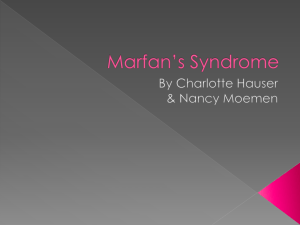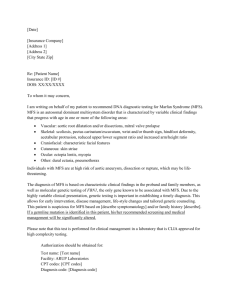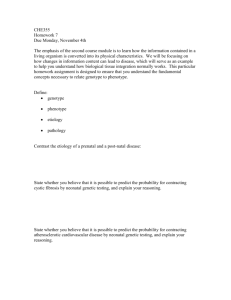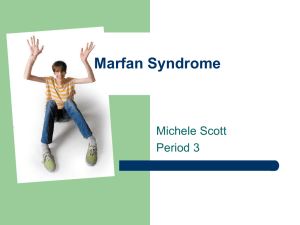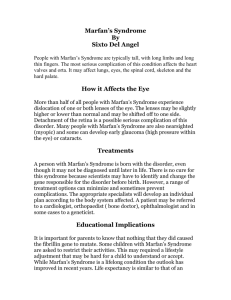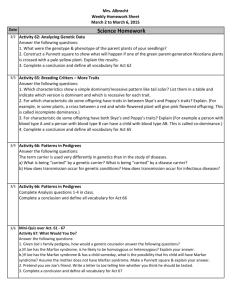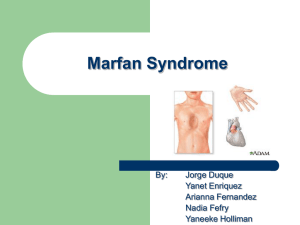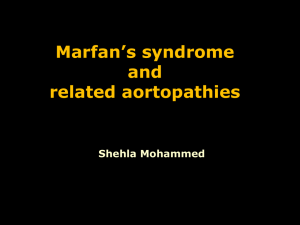Marfan Syndrome
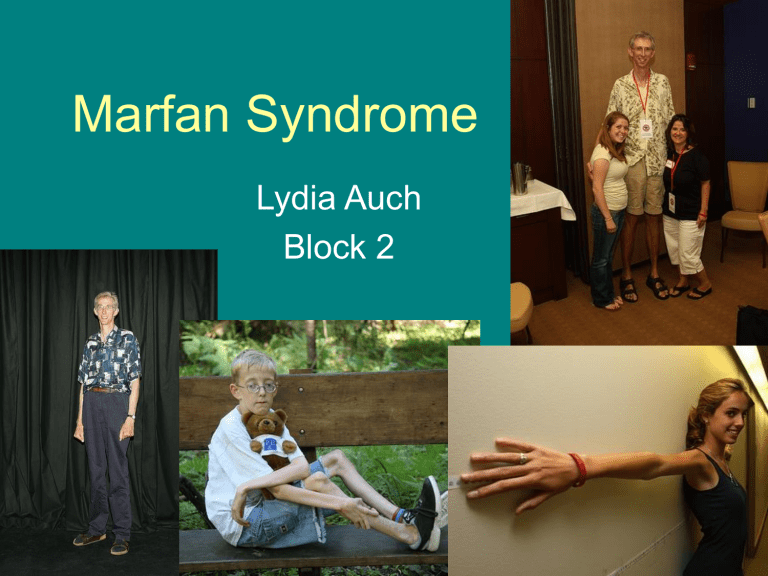
Marfan Syndrome
Lydia Auch
Block 2
History of Marfan’s Syndrome
• The disorder was first logged as a medical condition called arachnodacryly in 1896 by
Antonie Marfan.
• His findings however, had been suggested 20 years earlier by a doctor in Ohio.
• It was named arachnodacryly, from the Greek word for “spider”, arachne because of the long digits of those with Marfans.
• Today, the National Marfan Foundation is leading research.
• Anyone can be affected.
Diagnosis
• Scientists have discovered what mutation causes Marfan Syndrome (MFS)
• However, a genetic test alone can’t tell determine if you have MFS or not.
• So, diagnosis is made through a clinical evaluation such as an arm span greater than height.
• There are certain diagnostic criteria that are compared to a persons test results, history and physical examination.
Diagnosis
(Cont.)
Transmission
• MFS is caused by a mutation in the gene that tells the body how to make fibrillin-1.
• This results in an increase in a protein that causes problems in the connective tissue throughout the body.
• People most commonly inherit
MFS but 1 in 4 have a spontaneous mutation.
• There is a 50% chance of passing on MFS
Signs and Symptoms
Heart and Blood
Vessels (Cardiovascular system)
• Enlarged or bulging aorta, the main blood vessel that carries blood from the heart (aortic dilation or aneurysm)
• Separation of the layers of the aorta that can cause it to tear (aortic dissection)
• “Floppy” mitral valve (mitral valve prolapse – MVP)
Bones and Joints (Skeletal system)
• Long arms and legs
• Tall and thin body type
• Curvature of the spine (scoliosis or kyphosis)
• Chest sinks in (pectus excavatum) or sticks out/pigeon breast (pectus carinatum)
• Long, thin fingers
•Flexible joints
•Flat feet
•Teeth that are too crowded
Eyes (Ocular system)
•Severe nearsightedness (myopia)
•Dislocated lens of the eye
•Detached retina
•Early glaucoma
•Early cataracts
Other Body Systems
•Stretch marks on the skin, not explained by pregnancy or weight gain
•Sudden collapse of the lung
(spontaneous pneumothorax)
•Swelling of the sac around the spinal column (dural ectasia). This is found with CT or MRI scans of the back
(National Marfan Foundation, 2010)
Treatment
1.
Heart-Valve-Sparing Surgery-Part of the aorta is taken out and replaced with a woven tube but the persons aortic valve is left in place and attached to the tube.
Advantages
• Do not need to take blood thinning medication.
• No risk of forming clots
• Fewer concerns about becoming pregnant
Disadvantages
• Newer procedure and less experience
• Not available in all parts of the country
• Not an option for everyone.
Treatment
(Cont.)
2.
Scoliosis- Spinal Surgery – Needed because of abnormally loose ligaments of the spine. Surgery involves straightening the spine and fusing it in place.
Advantages
• Usually Successful
• Patient can transfer own blood
Disadvantages
• Rods can come loose
• Nerve damage
Treatment
(Cont.)
3.
Eye Surgery – Lens Removal - Usually needed for lens dislocation, progressive cataracts, and uncorrectable vision.
Advantages
• Help balance pressures in the eye
• Prevent permanent blindness
Disadvantages
• Raises the risk of retinal detachment
• Risky and technically difficult
Reference List
• Beers, M. H. (2004). The Merck Manual of Medical
Information: Second Home Edition (Merck Manual of
Medical Information, Home Ed.) . New York.
• Marfan's syndrome, Information about Marfan's syndrome. (n.d.). Internet FAQ Archives - Online
Education . Retrieved May 22, 2010, from http://www.faqs.org/health/topics/14/Marfan-ssyndrome.html
• Tullis, J. (n.d.). Living With Marfan Syndrome. National
Marfan Foundation . Retrieved May 22, 2010, from http://www.marfan.org/marfan/2439/Living-with-
Marfan-Syndrome
• Tullis, J. (n.d.). About Marfan Syndrome. National
Marfan Foundation . Retrieved May 22, 2010, from http://www.marfan.org/marfan/2280/About-Marfan-
Syndrome
